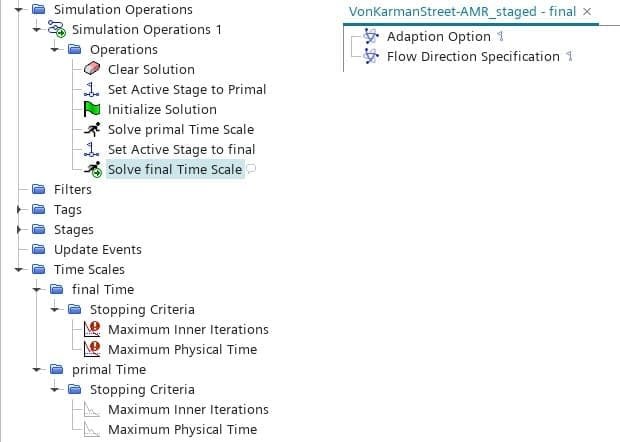Simulation Operations enable you to streamline the solution process in Simcenter STAR-CCM+ without relying on extra macros. While this feature has existed for a considerable period, governing the logic of complex template actions, certain functionalities were previously unavailable. As a result, we had to implement workarounds to access all features, as outlined in this example: Blog post on Marine Propeller simulation. However, the introduction of both Time Scales and the new Staged Physics declares these workarounds almost obsolete.
Time Scales
In time-accurate scenarios involving multiple continua, the physical response time for one continuum may significantly differ from others. For instance, fluid flow might reach full development and exhibit time periodicity with time scales in the order of milliseconds, while achieving thermal stability in the solid counterpart could necessitate tens of seconds. This discrepancy is particularly evident in conjugate heat transfer analyses involving both solid and fluid continua.
The introduction of time scales in Simcenter STAR-CCM+ serves as a powerful tool for Simulation Operations in managing simulations with diverse interacting physical processes, each characterized by its distinct time frame. This feature provides enhanced control and precision in simulation results by accommodating the varied temporal dynamics inherent in complex multi-physics simulations.

Time Scales provides a coupling strategy that permits distinct transient timescales for different regions, e.g. the solid and fluid components. Each Time Scale may have individual stopping criteria and discretization. But multiple groups of continua must share the same time solver (steady, implicit unsteady, PISO unsteady, etc.).
A practical example aside from the combination of solid and fluid continua, is the ability to dynamically switch temporal discretization as the simulation unfolds. This becomes particularly valuable when there is a need to first develop the flow field comprehensively before delving into the detailed analysis of the flow. You can seamlessly switch to finer temporal discretization to analyze intricate details of the flow with greater accuracy. This adaptive temporal strategy in Simcenter STAR-CCM+ enhances flexibility and efficiency in simulations, ensuring a balance between capturing the general trends early on and refining the analysis as the simulation advances.
Stages
In version 2310, the simulation automation capabilities are expanded through the introduction of the concept of Stages. The integration of Staged simulations enables you to store various configurations of physics settings and apply them sequentially throughout a simulation. This feature facilitates the staging of different objects within the simulation tree, with each object having distinct settings in each stage. Essentially, each configuration represents one stage in the simulation process. What you get is the ability to manually switch between stages, enabling them to run simulations with diverse configurations at different points in the simulation timeline. This enhancement provides a more dynamic and handy approach to managing simulation scenarios with evolving physics configurations.
How to get Stages?
Stages are now conveniently accessible as a new option within the Automation node. After introducing new stages, you can seamlessly switch between them using the dedicated toolbar located at the top right of the simulation tree window. By simply pressing the flag icon, you can directly stage an object from the simulation tree, initiating the process of configuring and managing different sets of parameters or conditions within each stage.

When the first stage is created the stage Manager is automatically opened, here all staged objects will be visible. E.g. select the physics models so that in one stage we have steady state and in another we have implicit unsteady.
What can be staged?
Simcenter STAR-CCM+ allows you to stage the following physics settings:
- Region settings — modify region type, physics conditions, physics values.
- Boundary settings — modify boundary type, physics conditions, physics values.
- Physics Models — modify physics models in a physics continuum. Currently, Simcenter STAR-CCM+ only supports the selection of Time models in a stage.
- Interface settings — modify interface type and settings.
- Solver settings — modify solver settings and the solver associated stopping criteria.

Multiple objects throughout the simulation tree can be effectively staged. To illustrate, let’s consider a practical example where stages are applied to a cylinder to create a von Karman vortex street (see example). Staging involves combining stages for boundary definitions with individual time scales for specific stopping criteria and time steps, as outlined above. In the primal stage, the focus is on developing the flow, with deactivating the Adaptive Mesh Refinement (AMR) and specifying Boundary-Normal for the Flow Direction Specification.
Simulation Operation can automatically switch to a second stage where AMR is active, and an angled inflow is specified. But we could even change the boundary conditions between the stages, e.g. a Symmetry Plane type boundary can become a Pressure Outlet in one stage.
This level of flexibility enables you to orchestrate a comprehensive simulation strategy with evolving configurations, contributing to a faster but accurate representation of complex physical phenomena. As always, if you have any questions or comments, please feel free to reach out to us at support@volupe.com. We are here to assist you.
The Author
Florian Vesting, PhD
Contact: support@volupe.com
+46 768 51 23 46
